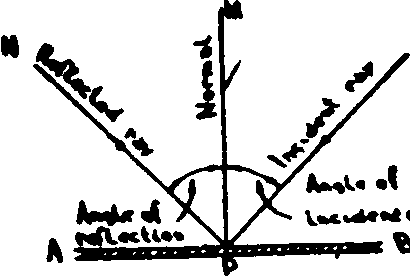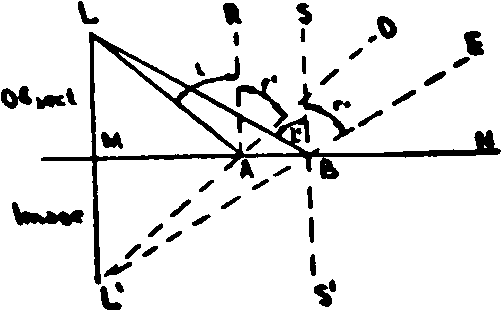
- •Reflection of light
- •Image in a Plane Mirror.
- •Reflection of light at an opaque surface
- •III. Answer the questions:
- •II. Answer the questions:
- •II. Answer the questions:
- •Principal focus
- •Construction of images in a concave mirror
- •Construction of images in a convex mirror
- •Parabolic mirrors
- •I. Translate and memorize:
- •II. Answer the questions:
- •I. Answer the questions:
- •II. Translate and memorize:
- •Polarisation
- •I. Answer the questions:
- •II. Translate and memorize:
- •Double reflection
- •II. Translate and memorize:
- •Nicol prism
- •I. Answer the questions:
- •Interference
- •Diffraction
Reflection of light
Laws of Reflection.
When a beam of light travelling in a homogeneous medium comes to another medium, some of the light is reflected back. When the surface of the second medium is polished or silvered, nearly all of the light is reflected, while in case of clear glass only a small part of it is reflected, the greater part entering the glass and passing through.
In Fig. I, let AB represent the reflecting surface, MP — the perpendicular (or the normal) to this surface, OP — the incident ray, and PN — the reflected ray. The angle ORM between the incident ray and the normal to the surface is called the angle of incidence, while that between the reflected ray and the normal to the surface is called the angle of reflection. When reflection takes place at such. a surface two laws of reflection are obeyed which are as follows:
First Law of Reflection: The incident ray, the reflected ray and the normal to the surface lie in the same plane.
Second Law of Reflection: The angle of incidence is equal to the angle of reflection.
Image in a Plane Mirror.
In case of a luminous object (e.g. the flame of a small candle) any point L of the source sends rays of light in all directions. If we place such a candle in front of a plane mirror MN (Fig. 2) two of these rays of light LA and LB, after being reflected by the mirror, travel in the directions AD and BE, respectively. To an observer in front of the mirror these rays seem to come diverging from a point behind the mirror. By drawing other rays it can be shown that they all seem, after reflection, to diverge from the same point behind the mirror. The observer will, therefore, see a bright spot behind the mirror, which is the image of the point L of the source, and for every point in the luminous body there will be a corresponding bright spot seen behind the mirror. There will, thus, be seen behind the mirror an image of the flame or any other luminous body placed in front of the mirror.
I.Translate into Russian:
1. Making a good reflector requires much polishing. 2. This surface is very well polished, thus making a very 'good reflecting surface. 3. No surface either silvered or aluminium should be considered as highly polished that reflects but 75 per cent of the light falling on it. 4. The angle between the incident ray and the normal to the surface is known as the angle of incidence, while that made by the reflected ray and the surface is , called the angle of reflection.
II. Answer the questions:
1. When does the phenomenon of reflection occur? 2. Does it take place in case of the ray passing through clear glass? 3. Do you know about "reflectionless optics" ("coated lenses") ? 4. What are the two laws of reflection? 5. What happens to the greater part of the light if it comes to the second medium the surface of which is not polished? 6. Under what conditions are the laws of reflection obeyed?
Fig. 1 Reflection of light from a plane mirror. The angle of incidence is equal to the angle of reflection. |
Fig. 2 Images in a plane mirror. The image is behind the mirror and of the same size as the object. |
III. Translate and memorize:
1. After the lectures Petrov and Sidorov went to their respective homes. 2. Mr. Petrov and Mr. Sidorov will graduate from the University in 1999 and 2004, respectively. 3. Heavy rain prevented us from leaving home. Work and all kinds of physical exercises prevent many and various illnesses from attacking people.
IV. Speak about reflection and the image in a plane mirror.


